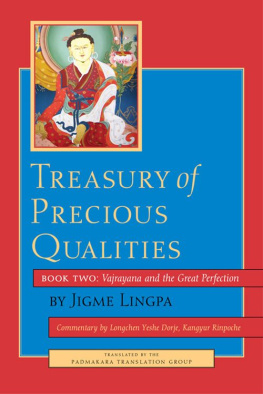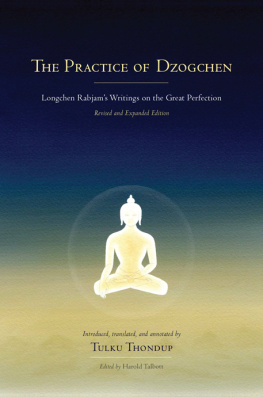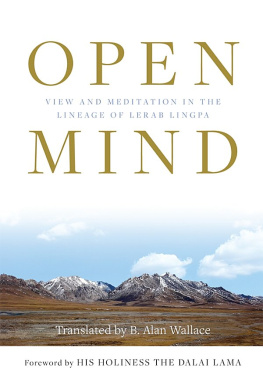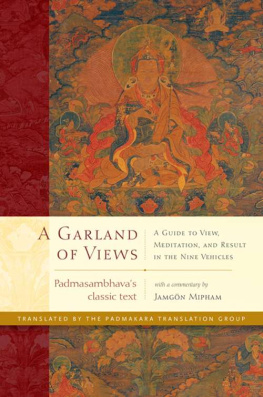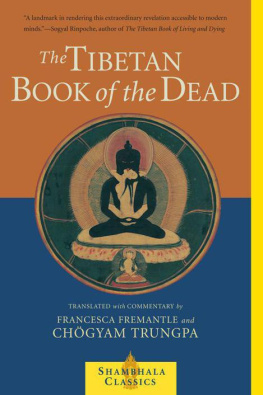Foreword
T he Profound Dharma of Natural Liberation through the Intention of the Peaceful and Wrathful Ones (Tib. Zab chos zhi khro dgongs pa rang grot) is a cycle of profound esoteric ritual texts and meditations on the peaceful and wrathful deities in the Nyingma (Tib. rNying ma) school of Tibetan Buddhism. The cycle reveals how to apply both the divine forms and the wisdom, that is, the pure quality and nature of the body and mind, as the forty-two peaceful (Tib. zhi) and fifty-eight wrathful (Tib. khro) deities.
The Profound Dharma of Natural Liberation and Karma Lingpa
The Profound Dharma of Natural Liberation was discovered as a hidden treasure text (Tib. gter ma) by Karma Lingpa (Tib. Karma Gling pa), one of the greatest discoverers, or terton (Tib. gter ston), of mystical teachings. In the ninth century, Tibetans benefitted from a 55-year-long visit to their land by Guru Padmasambhava, one of the greatest enlightened masters in Buddhist history and the founder of Buddhism in Tibet. At his disciples' request, Guru Padmasambhava condensed the inner esoteric teachings and wisdom of Buddhism in the form of the Profound Dharma of Natural Liberation. Then through the power of his wisdommind, he concealed (Tib. sbas) and entrusted (Tib. gtad rgya) the teachings and realizations of the Profound Dharma of Natural Liberation to the enlightened-nature of the minds of King Trisong Deutsen (Tib. Khri srong Ide btsan, 790-958) of Tibet, the King's sons and the famed translator Chog-ro Lu-gyaltsen (Tib. lCog ro Klu'i rgyal mtshan). Thereafter, Guru Padmasambhava encoded the Profound Dharma of Natural Liberation in dakini symbolic scripts (Tib. brda yig) on a yellow scroll (Tib. shogser) and concealed it at Daglha Gampo (Tib. Dwags lha sgam po) in Central Tibet.
In the fourteenth century, Chog-ro Lu-gyaltsen took rebirth as Karma Lingpa in Dagpo (Tib. Dwags po) valley in Central Tibet. Karma Lingpa's father was an adept known as Nyida Sangye (Tib. Nyi zla sangs rgyas). At the tender age of 15, Karma Lingpa discovered many profound treasure teachings from a dancing angel-like among them was the yellow scroll that contained the symbolic scripts of the Profound Dharma of Natural Liberation. By his decoding the symbolic scripts, the teachings and realizations of the Profound Dharma of Natural Liberation were instantly awakened in Karma Lingpa, just as if he had learned and experienced them a moment ago. He then transcribed the decoded teachings in the form of texts. After a year or so, Karma Lingpa transmitted the complete cycle of the Profound Dharma of Natural Liberation to his small son, Nyida Choje (Tib. Nyi zla chos rje), and, following the instructions in the prophetic guide (Tib. kha byang/ gter lung) of the Profound Dharma of Natural Liberation itself, advised him to keep the transmission of the teachings restricted to a single-person lineage for three generations. Then, although he was still in his youth, Karma Lingpa died.
Nyida Choje transmitted the Profound Dharma of Natural Liberation to Nyida Odzer (Tib. Nyi zla od zer), who in turn transmitted it to Namkha Chokyi Gyatso (Tib. Nam mkha chos kyi rgya mtsho), who finally promulgated it to a larger audience through many lineages. Thereafter, the Profound Dharma of Natural Liberation became one of the most popular texts in the Nyingmapa world of Tibet and it remains so. In addition to Nyingmapas, many great teachers and monasteries of the Kagyu school also practise the teachings.
In Eastern Tibet where I was born, the Profound Dharma of Natural Liberation was known as the Thotol (Tib. thos grol, liberation by hearing). It was one of the first major liturgical texts that novices study, not necessarily in order to learn its meaning, but to prepare to recite and chant at ceremonies. For advanced meditators who had studied the three inner tantras of the Nyingma school, the Profound Dharma of Natural Liberation was one of the standard sadhana texts used for putting their knowledge into practice and meditation.
The teachings of the Profound Dharma of Natural Liberation embody the essence of the three inner tantras: its teachings on the development stages (Tib. bskyed pa) embody the essence of Mahayoga teachings, such as the Guhyagarbhatantra; its teaching on the mandala of deities in the body (Tib. lus dkyil) and on the naturally liberated great bliss (Tib. bde chen rang grot) embodies the essence of Anuyoga teachings; its teachings on six bardos and six lights (Tib. sgron ma drug) embody the essence of Atiyoga.
The Six Bardos
The Profound Dharma of Natural Liberation, particularly those portions included in this volume, are the teachings on the bardo (Tib. bar do). Bardo means intermediate state or transitional state in Tibetan. In common parlance, bardo denotes the period between this life and the next. But here, bardo teachings apply to every transitional phase of life according to the essence of esoteric Buddhism. This includes life, death and after death; in short, every intermediate state and transitional moment. Further, different bardo states are either states of realization of the truth-as-it-is, or deluded states of the confused minds of ordinary beings. Therefore, teachings on bardo relate to every part of life.
The tantras and other Nyingma texts contain teachings on four bardos: the bardo of living (Tib. skye gnas), the bardo of dying (Tib. chi'i kha), the bardo of universal ultimate nature or dharmata (Tib. chos nyid) and the bardo of becoming (Tib. srid pa), which is the state between death and rebirth.
However, in the Profound Dharma of Natural Liberation, the essence of esoteric Buddhism is presented in the form of teachings on six bardos. The text says,
In accordance with The Seventeen Tantras of the Great Perfection (Tib.


